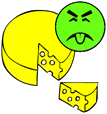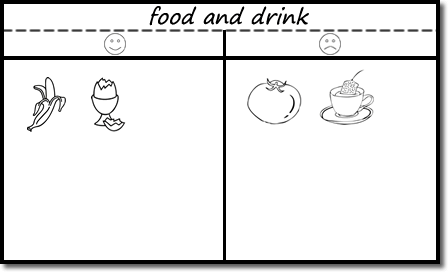Download a new song from ESL KidStuff: I Don’t Like Cheese!
 I Don’t Like Cheese (Likes & Dislikes song)
I Don’t Like Cheese (Likes & Dislikes song)
Song Theme: Talking about your likes and dislikes
Target Vocab: I like ~, I don’t like~, cheese, chocolate, rice, French fries, strawberries, bread, ice cream, grapes, pasta, pizza, beans, food, drink, very nice, what a stink!.
Song Length: 1:27
A funny song about food likes and dislikes.
(Members can log in to download the full song)
Lyrics:
Verse 1:
I like chocolate,
I like rice,
I like French fries,
They’re very nice,
I like strawberries,
I like bread,
Oh no, what’s that?
I don’t like cheese!
Chorus:
Cheese, cheese,
I don’t like cheese,
Cheese, cheese,
Don’t give me, please!
I like lots of food,
I like lots of drink,
But as for cheese – what a stink!
Verse 2:
I like ice cream,
I like grapes,
I like pasta,
It tastes great!
I like pizza,
I like beans,
Oh no, what’s that?
I don’t like cheese!
Chorus
Gestures and activities to use with the “I Don’t Like Cheese” song
There are no gestures for this song – a listening activity with worksheet accompanies the song (see point 3 below). However, if students enjoy the song you can encourage them to sing along and dance!
Here is the worksheet: Click here to download the “I Don’t Like Cheese” song worksheet
- students listen to the song and draw the food items they hear in the ‘I like’ and ‘I don’t like’ columns (only cheese is in the “don’t like” column). The song runs through the vocab pretty quickly, so play the song at least twice.
Using the “I Don’t Like Cheese” song in class
This is a really fun song which uses the key structures in a funny way – students have to listen to the song to complete their worksheets.
- Introduce “I like” and “I don’t like”. Start off by preparing your board as shown below (without the food drawings). Also, have the following flashcards printed out (just in case): cheese, chocolate, rice, French fries, strawberries, bread, ice cream, grapes, pasta, pizza, beans.
The board should be divided into two sections: “likes” on the left and “dislikes” on the right (indicated with a smiley and unhappy face).

As a class you are going to draw food and drink items you like and don’t like, as follows:
- First, draw a food or drink in the ‘like’ column (such as a banana). Get everyone to shout out what you have drawn. Gesture that you like this (say “Yummy!” and rub your tummy and smile – make it obvious that you like it a lot). Say “I like bananas”.
- Next, draw something in the ‘dislike’ column (such as a tomato). Again, get everyone to shout out what you have drawn. Gesture that you don’t like this (say “Yuk!” or “It stinks!” and grimace – make it obvious that you don’t like it). Say “I don’t like tomatoes”.
- To make sure everyone understands, draw another food/drink item in the like and dislike columns, using the same structures and gestures as before. This will turn into a fun guessing game as everyone tries to guess what is being drawn.
- Next, your students are going to draw some pictures on the board. Invite a student up and point to the ‘like’ column and say “Draw a food or drink that you like”. When the student draws the item, everyone has to guess what it is. Then get the student to say “I like ~”. The next student should draw something in the ‘dislike’ column and say “I don’t like ~”. Keep bringing students up to the board to draw their likes and dislikes until the board is pretty full.
- If any of the items from the song haven’t been drawn (cheese, chocolate, rice, French fries, strawberries, bread, ice cream, grapes, pasta, pizza, beans) use the flashcards to get them on the board: hold up each picture and elicit the word, then ask students to place the flashcard (use blue tak or tape) on the board in the column of their choice (whilst saying “I like ~” or “I don’t like~”).
- Controlled Practice saying “I like ~” and “I don’t like ~”. Put the students into pairs. They are going to make sentences using the food and drink items on the board. Model with a student first so everyone understands what to do: Teacher says “banana” – choosing an item from the board. The student has to make a sentence (e.g. “I like bananas”), The answer should be the student’s own true answer. Then in pairs, students take turns in choosing a food item for their partner to make a sentence about. For example:
Student A: apples
Student B: I like apples!Student B: carrots
Student A: I don’t like carrots!Also, encourage the use of phrases such as “Yummy”, “Yuk” and “It stinks”. Pairs keep talking until they have gone through all of the items on the board.
- Play the song “I Don’t Like Cheese” and students fill in their worksheets. For this song, students listen and fill in their worksheets by drawing the different food items they hear. The song runs through the vocab pretty quickly, so play the song at least twice.
Click here to download the “I Don’t Like Cheese” song worksheet.
After playing the song a few times, elicit the answers and put the flashcards on the board in the right columns so everyone can check (there will only be “cheese” in the ‘I don’t like’ column). Play the song through once more, pointing at the items on the board – encourage everyone to sing along. Alternatively, you could use the “I Don’t Like Cheese” song poster.
- Magazine cut outs. Now everyone is going to make a poster showing the food and drink they like / dislike. You will need some supermarket magazines for this – many supermarkets have free magazines showing the food they have on sale – collect as many as you can before the lesson. Give each student a large piece of paper (construction paper or card, if possible), scissors, glue and a magazine (you can group students together to share magazines). On the paper, each student should write their name at the top and then make a table with two columns titled “I like …” and “I don’t like”. Then they can go through the magazines and cut out and glue food and drink pictures into the correct column on their posters.
As the students are working on this, circulate, helping with vocab and asking questions (e.g. What’s this, Do you like ~, etc.).
When everyone has finished, get each student to hold up their posters and explain what they like and dislike. If you have a large class, you can do this in pairs or groups.
- Play the “Funny Food Likes & Dislikes Game”. This is a really fun way to end the lesson. You will need put the class into groups of 3 or 4 and give each group a die and the following handout (if you can enlarge it to A3 size it would be better):
Funny Food Likes & Dislikes Game handout
Instructions:
Before the game starts write the following on the board:1. pizza
2. soup
3. ice cream
4. sandwich
5. juice
6. cake- Play the game in groups of 3 or 4. Everyone sits around the game board. Decide who goes first and play in a clockwise direction around the game board.
- Player 1 rolls a die onto the game board paper. Look at which food item it lands on and the number of the die.
- The player must then make a sentence with the food item and using the number on the board. E.g. If the die lands on the cheese picture and number 3 s/he must say:
“I don’t like cheese ice cream!”
or
“I like cheese ice cream” (in this case, probably not!) - Cross out that picture with a pencil.
- The next player must roll the die. If the die lands on a crossed out picture s/he misses a turn (also miss a turn if the die doesn’t land on a picture at all). If the die lands on a new picture, s/he must make another like / don’t like sentence.
- The game continues until all of the pictures are crossed out.
At the end of the game you can ask everyone to tell you the strangest thing they made a sentence about (e.g. “I don’t like hamburger ice cream!”).
- Set Homework: For homework, give out the “Food likes & dislikes 1” or “Food likes & dislikes 2” worksheet (depending on the level of your students).
Related Stuff:
- Download all songs
- The Hello Song and The Goodbye Song
- The Numbers Song
- The ABC Song
- Head, Shoulders, Knees & Toes
- The Rainbow Song
- Old MacDonald
- What Can You Do?
- The Feelings Song
- The Days of the Week Song
- Months March song
- How Did You Get Here Today?
- Mr. Shape Head
- Let’s Go to the Zoo
- What Fruit do you Like?
- Where are my Things?
- The Morning Routines Song
- If You’re Happy and You Know It
- What Time is it?
- What’s Wrong? What’s the Matter?
- Numbers 1-20 song


